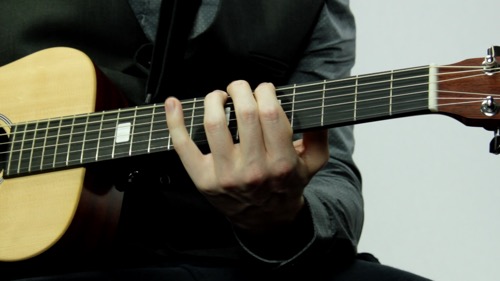Warm Up with the Major Scale

Hi. This is Hub Guitar.
Before you try to read a piece of music, it's a good idea to do some preparation. This will make your job a lot easier.
First, you want to check the range and make sure you're in the right position on the guitar. You want to try to find an area of the guitar where you can play all of the notes in the written music, or at least as many as possible.
Then you want to take a look at what key it's in. Usually that will give you a clue to approach it.
For instance, if the music is in C major, and the lowest note is this G here and the highest note is this G, then you'll want to warm up with a C major scale in the first position. Most of the notes you'll have to read will probably be in that scale.
So warming up with the scale is not just a vague exercise. It has very real uses. If the melody moves by step, you just go up the scale. If the melody moves up in thirds, you play the scale in thirds. As much as possible, you want to be reading the music by following along with the scale.
Let's take a look at a few of these scales. I'm going to show you some different C major scales, starting with this C major scale in the first position. Next I'm going to show you a C major in the fifth position. Now let's do it in position seven.
So when you see a piece of music, try to figure out what key it is and ideally what position is ideal to play it. Then warm up by playing the notes in that key, or the major scale, in that position.
Before you read a piece of music, you want to look at the rangeRange is the total melodic distance an instrument is capable of, from lowest possible note to highest possible note. It can also mean the total distance between the highest and lowest notes in a melody or musical part. of the melody and try to determine what position would be best to read it with.
Then, it’s a good idea to look at the keyThe set of pitches that a piece of music is organized around. A key has two components: a tonal center and some sort of scale, or set of pitches used for creating harmony and melody. of the example. And play the corresponding scale in the guitar position that best matches the range. (i.e., play a scale in such a position that all of the notes can be reached in that position without moving to another position.)
Getting Ready to Read
When we look at a piece of music that we’re about to read, we want to quickly know the answer to a few questions, like:
- Is this written for my guitar, or some other instrument?
- What is the range of this thing? What’s the lowest note and the highest note?
- According to the range, where should I play this on guitar?
- What’s the key signature? What notes should I be watching out for?
In this lesson, we’ll play through some major scales, and get a better idea of the relationship between key and position. In other words, how certain keys fit better in some guitar positions than the other. And how the range available to the player will change based on what position used.
Try to give the same duration to each note.
Be sure to play through all of the examples. Turn off your phone and get to work! You have to get through a bit of drudgery to learn this skill. Although sometimes your practice may be a little difficult, being able to read music is not boring!
C major, Position I

In this position, we’ll start with G, the 5th note of the key and climb up, using plenty of open strings. We can access the low G, and even lower, but our highest note is not very high. Not a good choice for C major melodies that are higher in range.
C major, Position V

For C major, this position is a little more flexible. We still have access to low “A”, and now we can reach a high “C” as well. This is useful for many melodies for guitar, but many melodies will have notes outside of this range as well.
C major, Position VII

This position lets us reach a few of the higher notes. With a bit of a stretch we would have little problem playing an “E” above the highest note. This position is good for melodies with lots of high pitches.
F major, Position I

F major, Position V

Key Result
- After practicing these scales, you should be able to use them to read a simply melody in any of the keys presented here.
 As the creator of Hub Guitar, Grey has compiled hundreds of guitar lessons, written several books, and filmed hundreds of video lessons. He teaches private lessons in his Boston studio, as well as via video chat through TakeLessons.
As the creator of Hub Guitar, Grey has compiled hundreds of guitar lessons, written several books, and filmed hundreds of video lessons. He teaches private lessons in his Boston studio, as well as via video chat through TakeLessons.